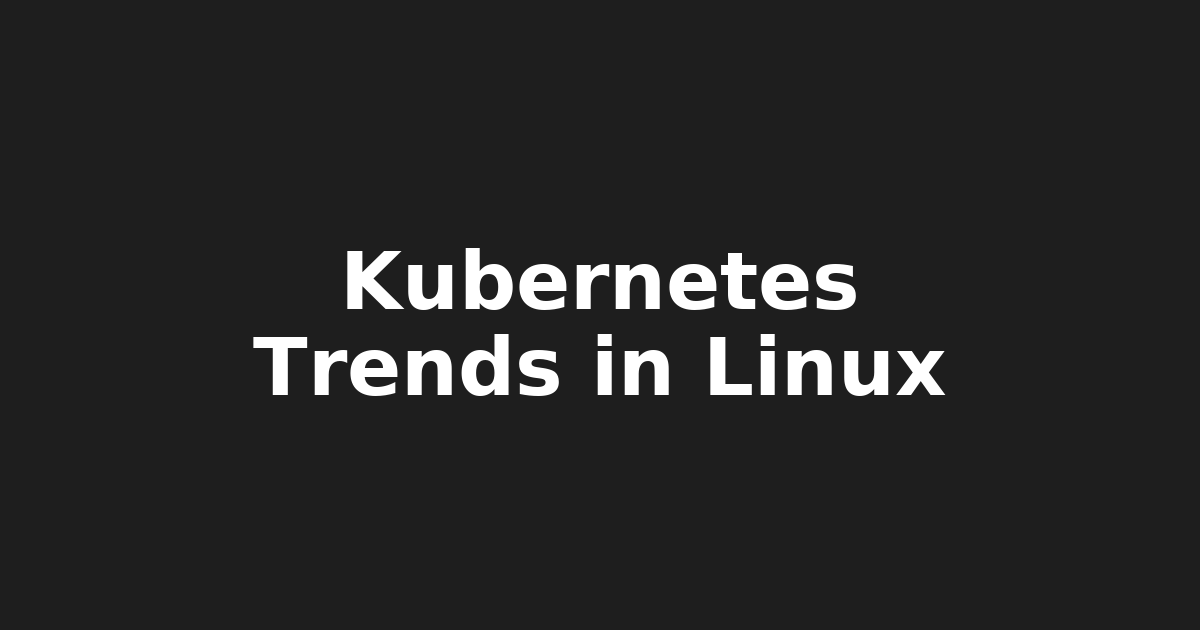Kubernetes Trends in Linux Environments

Kubernetes (K8s) in Linux Environments: A Comprehensive Guide
Introduction
Kubernetes, also known as K8s, is an open-source container orchestration system for automating the deployment, scaling, and management of containerized applications. It has gained immense popularity among developers, Linux users, system administrators, and IT professionals due to its ability to simplify the process of deploying and managing modern cloud-native applications.
Why Kubernetes is Trending
Kubernetes has been widely adopted in the industry, with many companies using it to manage their containerized applications. Some of the key reasons why Kubernetes is trending include:
- Growing adoption: According to a survey by Red Hat, 70% of organizations are already using Kubernetes, and this number is expected to grow even further.
- Improved scalability: Kubernetes provides a scalable and efficient way to deploy and manage containerized applications, making it an attractive choice for large-scale enterprises.
- Increased security: Kubernetes provides built-in security features such as network policies and secret management, which are essential for securing containerized applications.
- Simplified deployment: Kubernetes simplifies the process of deploying and managing containerized applications, reducing the time and effort required to get them up and running.
Current Use Cases
Kubernetes is widely used in cloud-native environments to deploy and manage applications such as web servers, databases, and messaging systems. Some of the current use cases for Kubernetes include:
- Cloud-native applications: Kubernetes is well-suited for deploying and managing cloud-native applications, which are designed to take advantage of cloud computing resources.
- Microservices architecture: Kubernetes provides a flexible way to deploy and manage microservices-based architectures, making it an attractive choice for companies adopting this technology.
- DevOps: Kubernetes simplifies the DevOps process by providing a single platform for developing, testing, and deploying applications.
Popular Tools and Frameworks
Kubernetes has a wide range of tools and frameworks available to support its use. Some of the most popular ones include:
- kubectl: The command-line tool for interacting with Kubernetes clusters.
- Helm: A package manager for Kubernetes that makes it easy to install and manage applications.
- Fluentd: A data collector that provides a simple way to collect logs and metrics from containerized applications.
Getting Started
Getting started with Kubernetes can be overwhelming, but there are several steps you can take to get started:
- Start with a tutorial: Begin with official tutorials or online courses that introduce you to Kubernetes basics, such as deploying and managing containers.
- Experiment with sandbox environments: Try out Kubernetes in a sandbox environment, such as Minikube or Kind, to get hands-on experience with the technology.
- Join online communities: Participate in online forums, such as Reddit's r/kubernetes, to connect with other users and learn from their experiences.
Best Practices for Deploying Applications on Kubernetes
Here are some best practices for deploying applications on Kubernetes:
- Use a CI/CD pipeline: Use a CI/CD pipeline to automate the build, test, and deployment of your application.
- Use container images: Use container images to package your application and its dependencies into a single unit.
- Use a service mesh: Use a service mesh, such as Istio or Linkerd, to manage traffic and security between services.
Security Considerations for Kubernetes
Kubernetes provides several built-in security features, including:
- Network policies: Network policies provide a way to control traffic between pods and services.
- Secret management: Secret management provides a way to store sensitive data, such as passwords and API keys, securely.
- Role-based access control: Role-based access control provides a way to control access to resources and actions.
Conclusion
Kubernetes is an open-source container orchestration system that has gained immense popularity among developers, Linux users, system administrators, and IT professionals. Its ability to simplify the process of deploying and managing modern cloud-native applications makes it an attractive choice for large-scale enterprises. By following best practices and staying up-to-date with the latest trends and use cases, you can leverage Kubernetes to improve your organization's efficiency and productivity.
References
- "Kubernetes: A Guide to Distributed Container Orchestration" by Red Hat
- "The State of Kubernetes in 2023" by Databricks
- "Kubernetes Security Best Practices" by Cloud Native Computing Foundation
